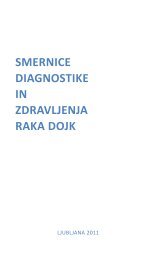You also want an ePaper? Increase the reach of your titles
YUMPU automatically turns print PDFs into web optimized ePapers that Google loves.
Inhibition of cathepsin L expression by siRNA influences<br />
susceptibility of U87 cells to apoptosis<br />
Sa{a Kenig and Tamara Lah Turn{ek<br />
Department of Genetic Toxicology and Cancer Biology, National Institute of Biology,<br />
Ve~na pot 111, 1000 Ljubljana, Slovenia<br />
Cathepsin L is upregulated in cancer and has been shown to be associated with<br />
invasiveness and tumorigenicity of various tumor cells. On the other hand, recent data<br />
on the implication of cathepsin L in apoptotic pathways are contradictory. Therefore,<br />
our aim was to study the effect of modulation of cathepsin L in glioblastoma cell line<br />
on the invasiveness and the susceptibility to apoptosis.<br />
We have impaired the expression of cathepsin L in glioblastoma cell line U87 by<br />
siRNA. Transfection efficiency was determined at mRNA, protein and activity level<br />
using RT-PCR, ELISA and fluorogenic substrate-based activity assay, respectively.<br />
U87 cells, transfected with non-silencing RNA duplex served as control.<br />
Cathepsin L mRNA level and activity were the lowest at 48 hours after transfection<br />
(10 and 39 % compared to control, respectively). As expected, cathepsin L silencing<br />
did not significantly affect cathepsin B expression or activity.<br />
Cathepsin L downregulation did not affect the invasiveness through Matrigel,<br />
measured by modified Boyden chamber assay. Apoptosis of U87 cells, induced<br />
either with staurosporine or with tumor necrosis factor α/actinomicin D (TNFα/ActD),<br />
was determined with acridine orange/ethidium bromide staining, caspase 3/7<br />
activity measurment and Bax/Bcl2 gene expression. In cells with impaired cathepsin<br />
L expression, induction with staurosporine resulted in a marked increase in early<br />
and late apoptotic cells compared to control cells. Similarly, after induction with<br />
TNFα/ActD, the number of late apoptotic cells was grater in cells with downregulated<br />
cathepsin L than in control cells. Activity of caspases 3 and 7 was found to be<br />
higher in cells with downregulated cathepsin L, when apoptosis was induced with<br />
staurosporine. On the other hand, there was no significant effect of cathepin L<br />
downregulation on caspase activity in TNFα/ActD-induced apoptosis.<br />
86p15<br />
These results suggest, that cathepsin L acts in antiapoptotic manner, but the<br />
mechanism of its action needs to be further invastigated.

















